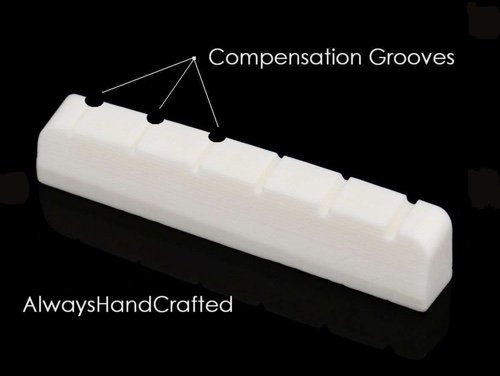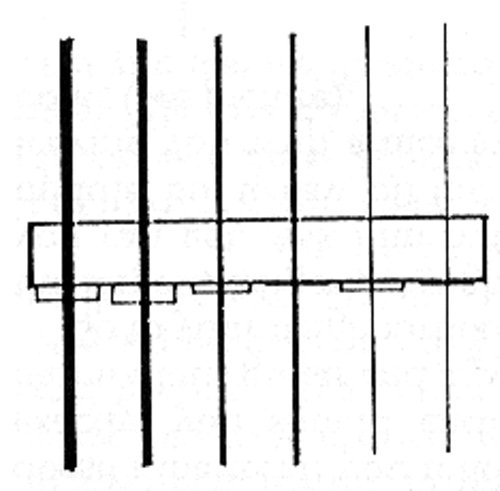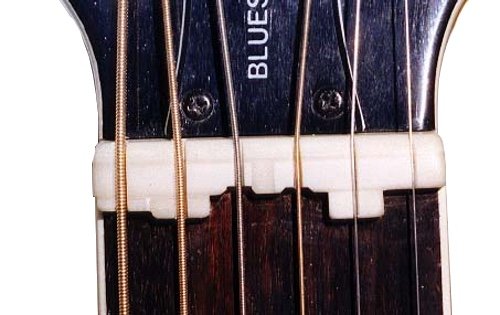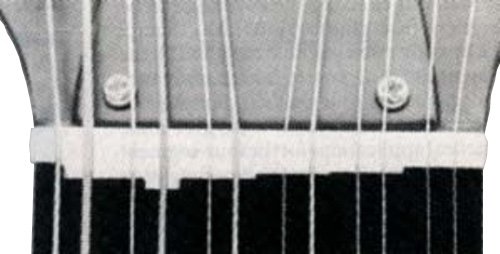You are using an out of date browser. It may not display this or other websites correctly.
You should upgrade or use an alternative browser.
You should upgrade or use an alternative browser.
Compensated nut
- Thread starter Wilmywood
- Start date
HeyMikey
Enlightened Member
Clever idea, but changing or adjusting nuts is much more of a PITA (at least to me) than doing it on the saddle.We've all heard of compenasted saddles, I am sure, but looking for a new nut, I ran across a compensated nut.
eBay link
Anyone tried one? Did it work?
Thoughts?
When thinking about about a compensated nut, it can help to first gain a more broad understanding of compensation, as in, what is the purpose?
If all of the strings on the steel string guitar were the same diameter and of identical tension, you would not require any compensation - your saddle would be straight across, perpendicular to the string path. But all the strings are not the same diamter, nor are they of the same tension. So the saddle is angled back on the bass side to "compensate" for the varying string diameters and tensions. The compensated saddle makes the most significant, pragmatic and easiest to maintain change in the otherwise mathematical theory that is the fretted guitar.
Making the mechanical change to the angle of the saddle also affects intonation, or how accurately the notes play up and down the fretboard. Intonation is a precise relationship between nut position, fret position, saddle position and string (or “scale”) length. Improving or perfecting intonation may be the quintessential slippery slope: it is possible to create or modify an acoustic guitar such that it plays so accurately that you will never be invited to play with others. Seriously. Your guitar will sound consistently “out of tune” to them and/or they will always be flat or sharp to you. But it *is* perfectly in pitch. Their instruments are not. Getting an instrument to play that precisely is achievable, though it requires more than just a compensated saddle.
The second change you can make in that direction (with the angled saddle being the first change) is to widen the saddle and individually compensate each string. Not doing so is not wrong. Many prefer the “the happy medium” approach, where the saddle is compensated (pitched at an angle) but remains super thin - a simple, straight line for the strings to pass over.
A compensated nut is a more complex issue, and is the third change you can make. The compensated nut addresses scale length (the precise distance between the nut and the saddle or, more accurately, between the point the string leaves the nut and crests the saddle. Altering scale length is what we did when we compensated the saddle by routing the slot at an angle. Intonation shows its ugly head by reminding us of the precise placement (position) of the frets. Compensating the nut accommodates the relationship between the scale length, the saddle location, and the existing fret placement. Adding a compensated nut (typically) requires an adjustment to the saddle.
But that brings us to our final change that can be made in pursuit of the ultimately accurate fretted instrument: the multi-scale fretboard. The most popular approach to a multi-scale fretboard is perhaps better known as “fanned frets.” Each string is assigned its own scale length and, as a result, each string gets its respective corresponding fret placement (the distance between the frets is exponentially larger for longer scale lengths).
If all of the strings on the steel string guitar were the same diameter and of identical tension, you would not require any compensation - your saddle would be straight across, perpendicular to the string path. But all the strings are not the same diamter, nor are they of the same tension. So the saddle is angled back on the bass side to "compensate" for the varying string diameters and tensions. The compensated saddle makes the most significant, pragmatic and easiest to maintain change in the otherwise mathematical theory that is the fretted guitar.
Making the mechanical change to the angle of the saddle also affects intonation, or how accurately the notes play up and down the fretboard. Intonation is a precise relationship between nut position, fret position, saddle position and string (or “scale”) length. Improving or perfecting intonation may be the quintessential slippery slope: it is possible to create or modify an acoustic guitar such that it plays so accurately that you will never be invited to play with others. Seriously. Your guitar will sound consistently “out of tune” to them and/or they will always be flat or sharp to you. But it *is* perfectly in pitch. Their instruments are not. Getting an instrument to play that precisely is achievable, though it requires more than just a compensated saddle.
The second change you can make in that direction (with the angled saddle being the first change) is to widen the saddle and individually compensate each string. Not doing so is not wrong. Many prefer the “the happy medium” approach, where the saddle is compensated (pitched at an angle) but remains super thin - a simple, straight line for the strings to pass over.
A compensated nut is a more complex issue, and is the third change you can make. The compensated nut addresses scale length (the precise distance between the nut and the saddle or, more accurately, between the point the string leaves the nut and crests the saddle. Altering scale length is what we did when we compensated the saddle by routing the slot at an angle. Intonation shows its ugly head by reminding us of the precise placement (position) of the frets. Compensating the nut accommodates the relationship between the scale length, the saddle location, and the existing fret placement. Adding a compensated nut (typically) requires an adjustment to the saddle.
But that brings us to our final change that can be made in pursuit of the ultimately accurate fretted instrument: the multi-scale fretboard. The most popular approach to a multi-scale fretboard is perhaps better known as “fanned frets.” Each string is assigned its own scale length and, as a result, each string gets its respective corresponding fret placement (the distance between the frets is exponentially larger for longer scale lengths).
Nuuska
Enlightened Member
Clever idea, but changing or adjusting nuts is much more of a PITA (at least to me) than doing it on the saddle.
That sentence brings up answers that would have me kicked out of this forum for a week or two.
But - seriously about intonation of guitar.
IF the fretboard is correct - adjusting intonation at nut would help when fretting at 1st - but ruining rest of the scale.
usually the problem is that nut slots are left too high - therefore fretting at 1st stretches the string too much - causing too high note.
Real remedy IMHO is to adjust the nut slots deep enough to get things righ - or have 0-fret.
Nuuska
Enlightened Member
Then there is one thing - that Chris does not mention in his great writing. I'm 100% sure he knows it.
No instrument w fixed pitches ( that we're trying to achieve w various constructions ) can be perfectly in tune.
Nature of music - mathematically - explains this.
 en.wikipedia.org
en.wikipedia.org
No instrument w fixed pitches ( that we're trying to achieve w various constructions ) can be perfectly in tune.
Nature of music - mathematically - explains this.
Pythagorean comma - Wikipedia
I have a zero fret Epiphone 12 string that works really well.That sentence brings up answers that would have me kicked out of this forum for a week or two.
But - seriously about intonation of guitar.
IF the fretboard is correct - adjusting intonation at nut would help when fretting at 1st - but ruining rest of the scale.
usually the problem is that nut slots are left too high - therefore fretting at 1st stretches the string too much - causing too high note.
Real remedy IMHO is to adjust the nut slots deep enough to get things righ - or have 0-fret.
And that was my question also - would a compensated nut not throw all but the first frets' note out of tune?
...would a compensated nut not throw all but the first frets' note out of tune?
It depends. Our dear friends from your ebay link are not the first to attempt to provide a “one-size-fits-all” solution.

It is quite possible, on *your* guitar, and *if* you play predominately in the 1st position, you *may* notice an improvement in the pitch of those first three strings when chording.
If there is such a thing as a “properly” compensated nut, it incorporates a visually staggered “shelving.” The shelving is controlling the string (scale) length.
By “slotting” the E, B, and G strings, the ebay seller is lengthening the scale for those three strings, which is a common approach to compensating nuts. However, they are accomplishing this by moving fret Zero to a negative position, which does not address strings 4, 5, and 6, and definitely alters the intonation higher up the fretboard.
See drawing below for a common approach to a compensated nut.

Here is a compensated nut which has dramatically shortened the scale for the B string, not lengthened it.:

And here is a compensated nut on a 12 string.

Purchasing a "pre-compensated” nut to replace an existing nut, with the expectation that a guitar is now guaranteed to be in an “improved” state, may result in disappointment. There are so many factors at play, and understanding those factors prior to altering scale lengths at the nut is highly recommended. In fact, I think I can safely say that recommending otherwise is just plain...
…nuts.
Thanks, Christopher. I think I'll pass.
I'm not hyper sensitive to intonation, but I do intonate the strings individually on my acoustics by forming the top of the saddle to a wave. On my JF30-12 I added notches to compensate better than the wave could alone. I play the whole neck and feel the effort was well worth it for my acoustic guitars.Thanks, Christopher. I think I'll pass.
When I got my crossover (a Kremona Verea) I was getting sour notes on the G string at the first few positions with the intonation higher on the neck just fine. That's when I delved into a compensated nut. I kept mine simple, just adding a ledge to the G string and a very small ledge to the low E. It's not perfect, but the change significantly improved intonation over the whole neck for the songs I was playing. The ledge for the G was about .125" but I could probably trim it back to about .100". It is the only guitar I've bothered to do this on and probably the only one I will - it's my only nylon strung guitar with frets.
-Douglas C.
Prince of Darkness
Senior Member
- Joined
- Feb 17, 2018
- Messages
- 3,553
- Reaction score
- 9,443
- Location
- Boddam, North East Scotland.
- Guild Total
- 2
I have seen pictures of Zither Banjo's where they had a split second fret, with the section of fret for the first string is set slightly closer to the nut than the rest of the fret.
Hey, it's not exactly big $$ to try it, but I do not believe it's likely to help your intonation unless your guitar has gotten out of shape since it was built.
With manufacturers, a useful compensated saddle can be fashioned because they can build their necks and frets to spec and do the saddle compensation once and apply it across the board. I really don't think that a compensated nut is necessary if the guitar is built properly.
With manufacturers, a useful compensated saddle can be fashioned because they can build their necks and frets to spec and do the saddle compensation once and apply it across the board. I really don't think that a compensated nut is necessary if the guitar is built properly.